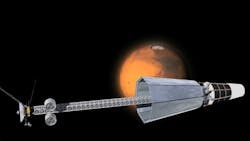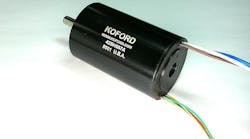THE AEROSPACE AND DEFENSE BLOG – U.S. military space experts are developing the ability to use nuclear power generation in orbit to provide electricity for a variety of future space applications ranging from small satellite sensor payloads to large integrated satellites, and even space stations orbiting the moon, Earth, and beyond.
The U.S. Space Force has engaged three defense systems integrators to design high- and low-power space nuclear power generation to support payload power and propulsion on future satellites and space stations.
U.S. Space Force, through the U.S. Air Force Research Laboratory Space Vehicle Directorate at Kirtland Air Force Base, N.M., is asking the defense contractors to design space nuclear power through the Joint Emergent Technology Supplying On-orbit Nuclear Power (JETSON) project.
The contractors are Intuitive Machines LLC in Houston, which is focusing on the JETSON Low Power System program; and Lockheed Martin Corp. Space segment in Littleton, Colo., and Westinghouse Government Services LLC in Hopkins, S.C., for the JETSON High Power Mission Application program.
JETSON is part of the Space Technology Advanced Research - Fast-tracking Innovative Software and Hardware (STAR-FISH) initiative, which seeks to develop enabling technologies for space-based radioisotope power systems.
Intuitive Machines won a $33.7 million contract for the JETSON Low Power System program, while Westinghouse won a $17 million contract and Lockheed Martin won a $33.7 million contract for the JETSON High Power Mission Application program. All three companies won their contracts at the end of September.
For the JETSON Low Power System, Intuitive Machines engineers will design space nuclear power generation for future propulsion and sensor payloads on small satellites. The company will find new ways to develop compact radioisotope power systems, electric and hybrid propulsion for power conversion, power management, on-orbit mobility, thermal regulation, deployable structures, radiation shielding, and electronic hardening.
The continuous power levels obtainable using space nuclear power may provide advantages over current solar electric power for mission payloads and spacecraft, and could enable a new generation of military small low-power applications, which will be a 1U design that consumes five Watts or less, with a propulsion system able to operate for one to two years.
The JETSON High Power Mission Application program, meanwhile, will develop enabling technologies for high-power space nuclear generation for propulsion and power for future satellites and space stations.
Lockheed Martin and Westinghouse Government Services will mature JETSON spacecraft systems and subsystems designs, and develop the overall space nuclear power program.
Nuclear electric power systems may provide unique advantages over conventional power systems for spacecraft, and drive enhancements to future space missions and spacecraft design that may lead to improved and new national security payloads for future defense missions, and switch away from traditional orbital operations that use solar arrays or other means.
The effort revolves around developing a fission reactor, thermal management, power conversion, radiation shielding, power management and distribution, and electric/hybrid propulsion systems.
This fission power system must be able to produce 6 kilowatts maximum and 4 kilowatts of power minimum; or 20 kilowatts maximum and 15 kilowatts minimum depending on power conversion redundancy.
This space nuclear power system will activate on-orbit, support propulsion system, and will provide fault-recovery management for power conversion system during non-steady-state thermal condition.
While nuclear power today has somewhat of a bad reputation, and is widely is considered to be dangerous, the ability to generate power in space by nuclear means has the potential to support a wide variety of orbital missions, starting with future long-term lunar exploration. It also has the potential to demonstrate utility and safety for possible future use in Earth orbit.



